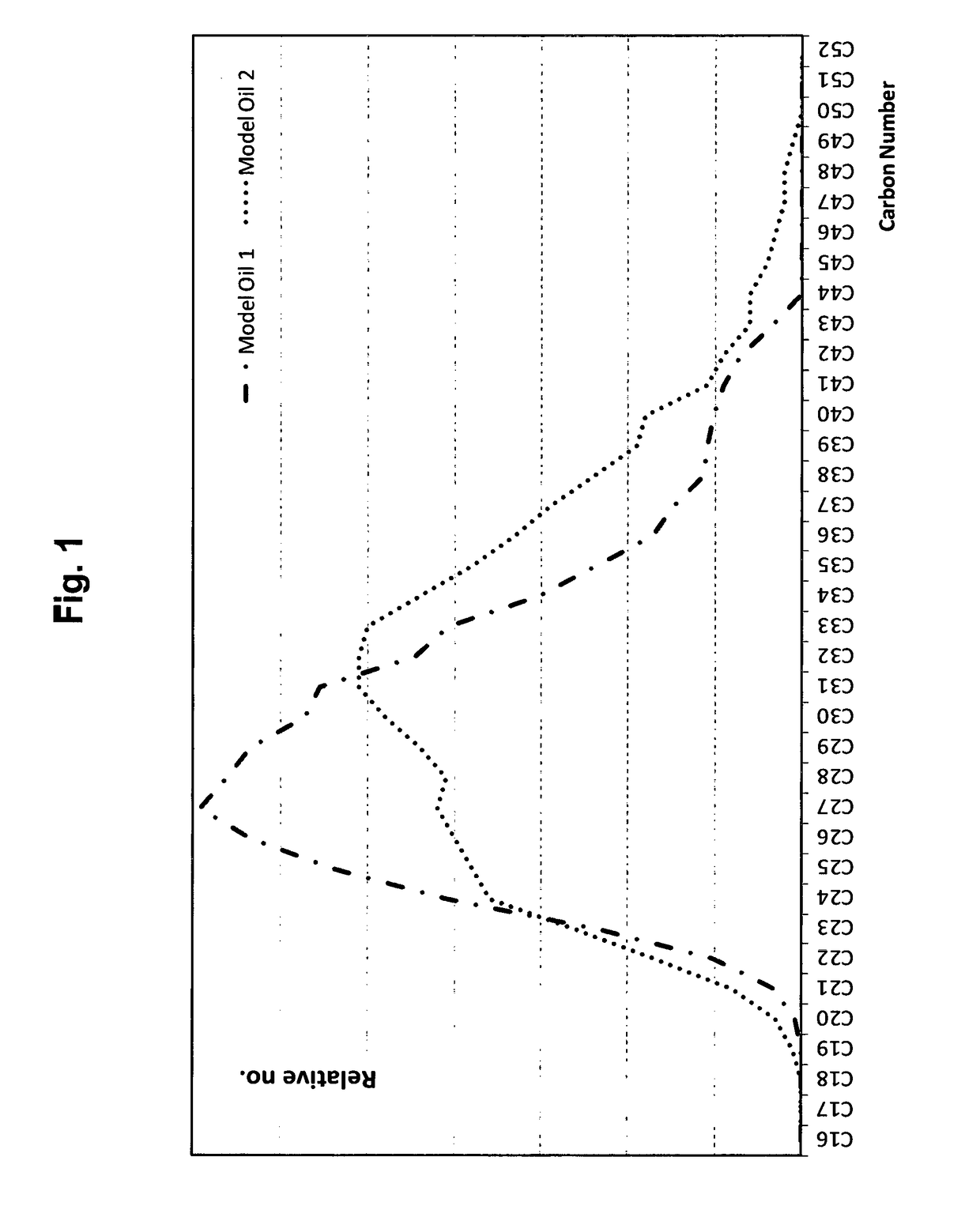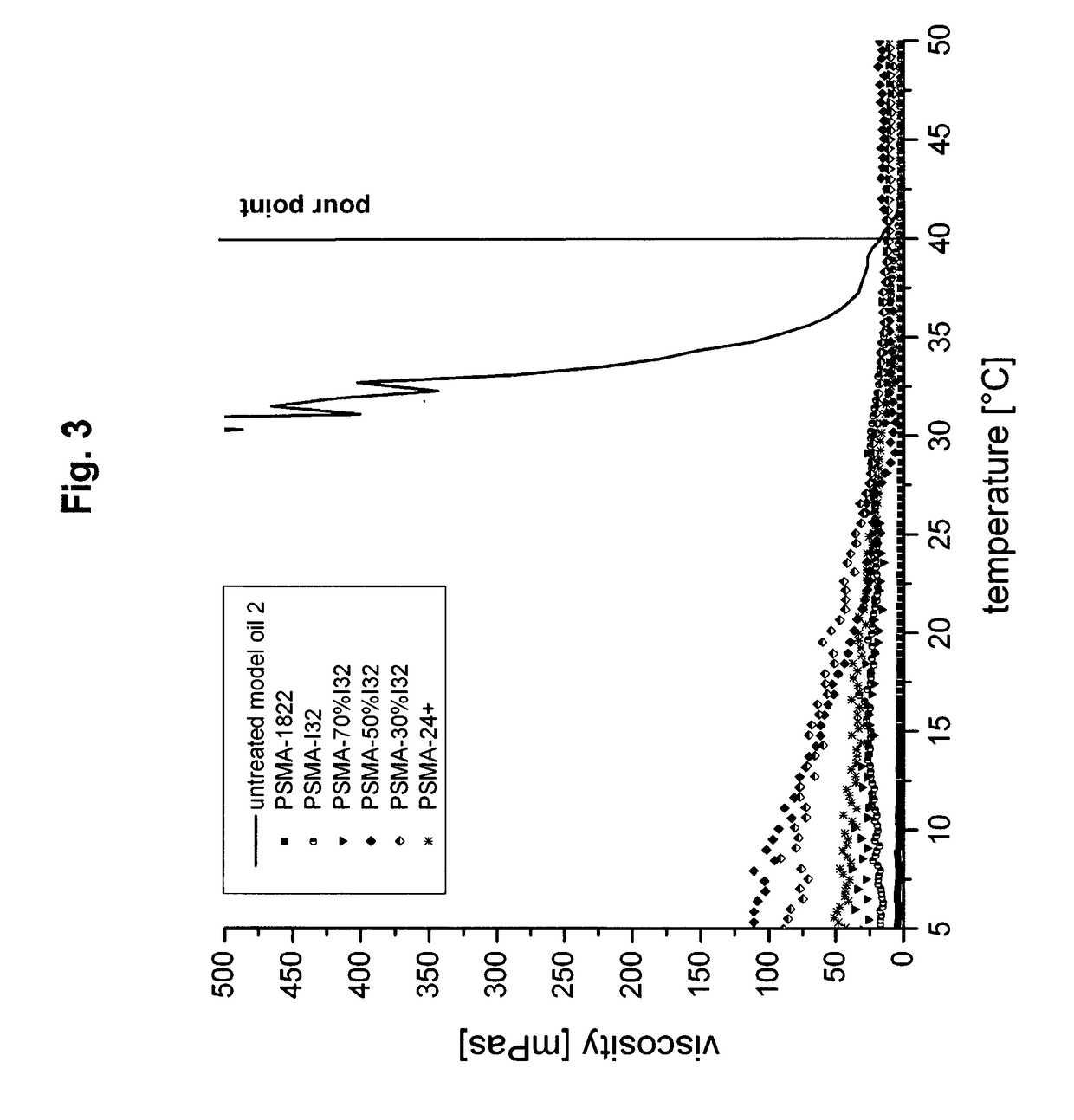Use of Polymeric Additives for Paraffin-Containing Fluids
- Summary
- Abstract
- Description
- Claims
- Application Information
AI Technical Summary
Benefits of technology
Problems solved by technology
Method used
Image
Examples
example 1
[0087]In order to determine whether the structure of the alkyl chains (whether branched, linear or a mixture of branched and linear chains) incorporated in the polymeric alkyl esters affect the ability of the additives to lower the pour point of paraffinic fluids, additives were prepared according to the general method described above. The esters were added to Model Oil 1 in both 200 and 400 ppm polymer quantities (the polymer was added as a 40 wt. % solution in xylene), and their ability to reduce the pour point of the oil was determined. Results are shown in Table 4.
[0088]The results in table 4 show that PPDs with mixed (linear and branched) alkyl esters (PSMA-70% I32, PSMA-50% I32 and PSMA-30% I32) show significantly higher pour point reduction values in Model Oil 1 than PPDs with either only branched alkyl chains (PSMA-I32) or only linear alkyl chains (PSMA-24+). For Model Oil 1 the 50% mixture of branched ester groups (PSMA-50% I32) delivered the best results.
[0089]FIG. 2 shows...
example 2
[0091]To compare the effect of the length and the relative amount of the linear alkyl ester groups in mixtures of styrene-maleic acid esters with linear and branched alkyl groups, the following mixtures of alcohols were prepared:[0092]A mixture of 70 weight % ISOFOL32 / 30 weight % NAFOL 24+[0093]A mixture of 70 weight % ISOFOL32 / 30 weight % NAFOL1822[0094]A mixture of 50 weight % ISOFOL32 / 50 weight % NAFOL24+[0095]A mixture of 50 weight % ISOFOL32 / 50 weight % NAFOL1822[0096]A mixture of 30 weight % ISOFOL32 / 70 weight % NAFOL24+[0097]A mixture of 30 weight % ISOFOL32 / 70 weight % NAFOL1822
[0098]These different mixtures were used to synthesise polymeric additives according to the general method as described above. Each compound was added in 200 and 400 ppm polymer quantities (the polymer was added as a 40 wt. % solution in xylene) to Model Oil 1, and the pour point reduction was recorded. Results are shown in Table 5.
TABLE 5Pour point reduction observed for the various flowimprovers eva...
example 3
[0100]In order to determine whether the ratio between styrene and maleic anhydride in the polymeric backbone of the ester, plays a role in the ability of the ester to lower the pour point of the paraffinic oil, polymeric alkyl esters were prepared according to the general method described above. The molar ratio of styrene:maleic anhydride was varied between 50:50 and 67:33. The esters were added to Model Oil 1 in both 200 and 400 ppm polymer quantities (the polymer was added as a 40 wt. % solution in xylene), and their ability to reduce the pour point of the oil was determined. Results are shown in Table 6.
TABLE 6Pour point reduction observed for the various flow improversevaluated: varying the styrene:maleic anhydride ratioin the backbone of the polymeric alkyl estersPOUR POINTReduction in Pour PointReduction in Pour PointDEPRESSANT(° C.)(° C.)(PPD)200 ppm PPD added400 ppm PPD addedPSMA - I32*22PSMA - 70% I321116PSMA - 50% I321218PSMA - 30% I321115PSMA - 24+**78COMM - I32*23COMM - ...
PUM
| Property | Measurement | Unit |
|---|---|---|
| Fraction | aaaaa | aaaaa |
| Fraction | aaaaa | aaaaa |
| Fraction | aaaaa | aaaaa |
Abstract
Description
Claims
Application Information
 Login to View More
Login to View More - R&D
- Intellectual Property
- Life Sciences
- Materials
- Tech Scout
- Unparalleled Data Quality
- Higher Quality Content
- 60% Fewer Hallucinations
Browse by: Latest US Patents, China's latest patents, Technical Efficacy Thesaurus, Application Domain, Technology Topic, Popular Technical Reports.
© 2025 PatSnap. All rights reserved.Legal|Privacy policy|Modern Slavery Act Transparency Statement|Sitemap|About US| Contact US: help@patsnap.com



